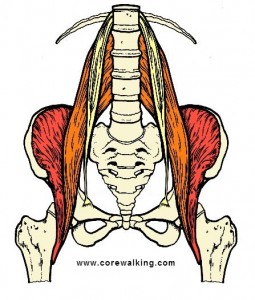 Anyone who reads this blog knows that I think the psoas major muscle is the key to healthy walking and standing. This extraordinary muscle is also essential to backbending in yoga. There are only three muscles that connect the arms and legs to the spine. The psoas major and piriformis connect the legs, and the latissimus dorsi connects the arm to the spine and pelvis.
Anyone who reads this blog knows that I think the psoas major muscle is the key to healthy walking and standing. This extraordinary muscle is also essential to backbending in yoga. There are only three muscles that connect the arms and legs to the spine. The psoas major and piriformis connect the legs, and the latissimus dorsi connects the arm to the spine and pelvis.
A successful backbend involves an extension of the spine that can’t happen without the help of the psoas major and the latissimus dorsi (I’ll covers the lats in a future post). The psoas must engage for the spine to lengthen at the back. This is a result of reciprocal inhibition, one of the body’s best magic tricks. For one muscle to lengthen, another muscle must shorten. For the muscles of the back and spine (erector spinea among others) to lengthen, the psoas must shorten or engage so that reciprocal inhibition can kick in.
This connects us to the earlier posts (here, here, here, ) that discussed the role of the feet, knees and pelvis in backbending. The feet, knees and legs all need to be in the right place for the psoas to do its thing. And its thing in backbending is to pull forward and slightly down drawing the lumbar vertebrae forward. This is the action that allows the opposite lengthening of the erector muscles of the spine.
In order for the psoas to accomplish this it must be correctly aligned at the back half of the inner thigh. The psoas attaches on the lesser trochanter, a knob on the back half of the thigh bone. It needs to be in the back of the body in order to create the necessary tension as the muscle crosses the pelvis to attach to the lumbar spine. If it is in the back plane of the body the proper tension is available. This can happen if the feet are grounded and the legs aligned.
The unfortunate tendency is for the feet to roll out and the knees to move out to the side. When this happens, the back half of the inner thigh moves towards the front half of the body and the requisite tension can’t manifest. We need the psoas to be properly aligned and engaging for a backbend to successfully lengthen the spine. If this doesn’t happen the back is much more likely to bend instead of lengthen leading to a compression in the bones of the lower spine. I really believe that a majority of students are compressing rather than lengthening the spine.
The psoas is the most important muscle in the body and its importance is never more evident than when backbending.
***
